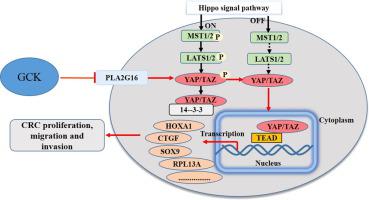Journal of Advanced Research ( IF 11.4 ) Pub Date : 2021-06-12 , DOI: 10.1016/j.jare.2021.06.009 Li Yang 1, 2, 3, 4, 5 , Lingjie Zheng 1, 3, 4, 5 , Xiaonv Xie 1, 3, 4, 5 , Junjia Luo 1, 3, 4, 5 , Jing Yu 1, 3, 4, 5 , Lihua Zhang 1, 3, 4, 5 , Wenhui Meng 1, 3, 4, 5 , Yingen Zhou 1, 3, 4, 5 , Ling Chen 6 , Dongsheng Ouyang 1, 3, 4, 5 , Honghao Zhou 1, 3, 4, 5 , Zhirong Tan 1, 3, 4, 5

|
Introduction
Colorectal cancer (CRC) is a common malignant tumor with a high global incidence, metastasis rate and low cure rate. Changes in lipid metabolism-related genes can affect the occurrence and development of CRC, and may be a potential therapeutic target for CRC. Therefore, starting from lipid metabolism-related genes to find natural medicines for tumor treatment may become a new direction in CRC research.
Objectives
This study aimed to investigate the effect of PLA2G16, a key gene involved in lipid metabolism, on the biological function of CRC, and whether the anti-CRC effect of GCK is related to PLA2G16.
Methods
To explore the role of PLA2G16 in CRC in vitro and in vivo, we performed cell proliferation, migration, invasion and nude mice tumorigenesis assays. As for the mechanism, we designed RNA-seq analysis and verified by western blotting and immunofluorescence experiments. Subsequently, we found the anti-CRC effect of GCK is related to PLA2G16 through western blotting and rescue experiments.
Results
We showed that PLA2G16 was significantly higher in CRC tissues than the adjacent normal appearing tissues, and high PLA2G16 expression correlates with unfavorable prognosis of CRC patients. Further, PLA2G16 promoted the malignant progression of CRC by inhibiting the Hippo signaling pathway determined by RNA-seq analysis, and GCK exerted anti-CRC effects by inhibiting the protein expression of PLA2G16 in vitro and in vivo.
Conclusion
Our results suggested that PLA2G16 promote the malignant progression of CRC by inhibiting the Hippo signaling pathway and the anti-CRC effect of GCK is through inhibiting the protein expression of PLA2G16.
中文翻译:

人参皂苷K靶向脂代谢基因PLA2G16抑制大肠癌恶性进展
介绍
结直肠癌(CRC)是一种全球发病率高、转移率高、治愈率低的常见恶性肿瘤。脂代谢相关基因的变化可影响结直肠癌的发生和发展,可能是结直肠癌的潜在治疗靶点。因此,从脂代谢相关基因入手,寻找治疗肿瘤的天然药物可能成为结直肠癌研究的新方向。
目标
本研究旨在探讨参与脂质代谢的关键基因PLA2G16对CRC生物学功能的影响,以及GCK的抗CRC作用是否与PLA2G16有关。
方法
为了在体外和体内探索 PLA2G16 在 CRC 中的作用,我们进行了细胞增殖、迁移、侵袭和裸鼠肿瘤发生试验。至于机制,我们设计了 RNA-seq 分析,并通过蛋白质印迹和免疫荧光实验进行了验证。随后,我们通过western blotting和救援实验发现GCK的抗CRC作用与PLA2G16有关。
结果
我们发现 CRC 组织中的 PLA2G16 显着高于邻近的正常组织,并且 PLA2G16 的高表达与 CRC 患者的不良预后相关。此外,PLA2G16通过抑制RNA-seq分析确定的Hippo信号通路促进CRC的恶性进展,而GCK通过在体外和体内抑制PLA2G16的蛋白质表达发挥抗CRC作用。
结论
我们的研究结果表明,PLA2G16 通过抑制 Hippo 信号通路促进 CRC 的恶性进展,而 GCK 的抗 CRC 作用是通过抑制 PLA2G16 的蛋白表达。











































 京公网安备 11010802027423号
京公网安备 11010802027423号